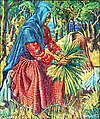Gaddis

The Gaddi is a semi-pastoral and Agriculture practising Indo Aryan ethno-Linguistic Group living mainly in the Indian states of Himachal Pradesh and Jammu and Kashmir.[citation needed]

Overview[]
The origin of the Gaddi Tribe is unclear and they also additionally believe that their ancestors fled from plains because of lack of security or foreign Invasions. The fact regarding their origination lies within the popular myths in the state. There is no accord of the views from where Gaddis migrated to this hilly state. The Gaddi nomenclature springs from the word "Gaderan", the native word for the hilly tracts of Himachal Pradesh. Gaddis, a Scheduled Tribe of Himachal Pradesh, are found principally focused in Bharmauri of Chamba district, an area popularly called ‘Gaderan’ which means ‘the home of the Gaddis’. Bharmour is additionally known as the abode of Gaddis.[citation needed] The term "Gaddi" conjointly refers to a territorial cluster of a special category of individual forming an exogamous union of Brahmin, Rajputs, Khatris and other castes whose Primary Traditional Occupation was Agriculture and Goat Herding. The word ‘Gaddi’ has been derived from a Sanskrit word "Gabdika" (गब्दिक) an Ancient Tribal Republic Mentioned in Paninis Ashtadhyayi where present day Gaddis are inhabited.Some views are commonly held among these folks like Kailash is the throne (gadi) of the Lord Shiva. Therefore,those people who took refuge and settled in Brahmaur also came to be referred as Gaddis.
Gaddis are semi nomadic, semi-agricultural and a semi-pastoral tribe. They have a defined culture, expressed through language, dress, food, marriage, song, and devout celebrations. Gaddis have their empyreal history deep- rooted in their endemic culture. In order to preserve their cultural heritage, they take pride in their culture and maintain cultural coherence from generation to generation. Gaddi is the language of Gaddi community and Tankri is the script used by the old people of the community. Other people spoke Hindi, whereas Devanagari is used as a script Caste system prevalent in gaddi community. Some are Gaddi Rajputand some are Gaddi Brahmin which are also called Bhatt Brahmin. They came in Chamba during the reign of ajai verma in 8 century. They are descendants of lord Shiva. They also believe in lord Kartikeya (kelang), gugga and awtars. Nuala celebrated by this community in which they chanted the aincheliya whole night and offer sheep to lord Shiva and dance whole night. They are one of honest community of world thats why the crime rate of himachal is lower than other states. According to the 2011 Census of India, the Gaddi population was 1,78,130 in Himachal Pradesh and 46,489 in Jammu Kashmir. The Gaddis of Himachal Pradesh had an adult sex ratio of 1014 and literacy rate of 73.3, whereas those of Jammu and Kashmir had a sex ratio of 953 and literacy of 53.5. They are classified as a Scheduled Tribe in both areas under India's reservation system.[1]
Gallery[]

Gaddi people Naddi Village, Dharamsala

Gaddi woman in traditional dress with children and dog

Gaddi woman cutting grass. Painting by Alfred Hallett c. 1980
References[]
- ^ "Statistical Profile of Scheduled Tribes in India" (PDF). Registrar of Census, Government of India. p. 170. Retrieved 1 May 2019.
Further reading[]
- Verma, V. 1996. Gaddis of Dhauladhar: A Transhumant Tribe of the Himalayas. Indus Publishing Company, New Delhi.
External links[]
| Wikimedia Commons has media related to Gaddi. |
- Scheduled Tribes of Jammu and Kashmir
- Scheduled Tribes of Himachal Pradesh
- Transhumant ethnic groups


